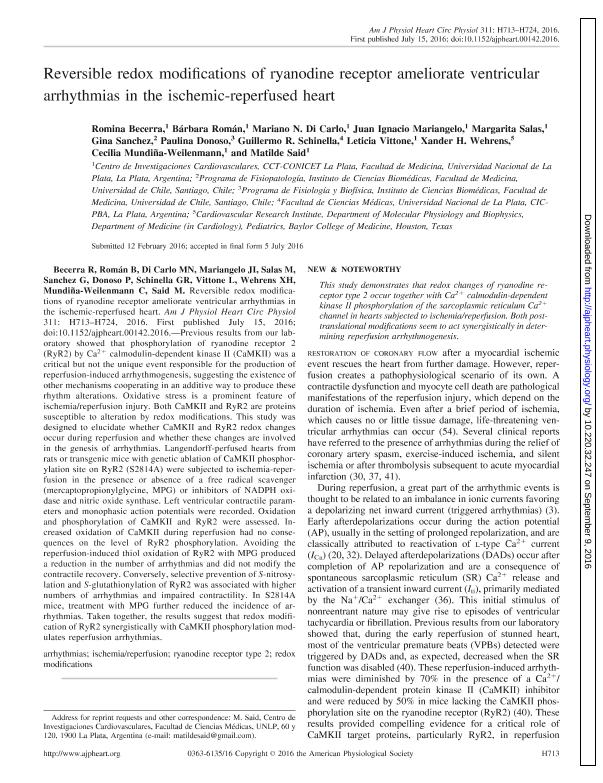Artículo
Reversible redox modifications of ryanodine receptor ameliorate ventricular arrhythmias in the ischemic-reperfused heart
Becerra, Romina Valeria ; Roman, Barbara Soledad
; Roman, Barbara Soledad ; Di Carlo, Mariano Nahuel
; Di Carlo, Mariano Nahuel ; Mariángelo, Juan Ignacio Elio
; Mariángelo, Juan Ignacio Elio ; Salas, Margarita Ana; Sanchez, Gina; Donoso, Paulina; Schinella, Guillermo Raúl; Vittone, Leticia Beatriz
; Salas, Margarita Ana; Sanchez, Gina; Donoso, Paulina; Schinella, Guillermo Raúl; Vittone, Leticia Beatriz ; Wehrens, Xander H.; Mundiña, Cecilia Beatriz
; Wehrens, Xander H.; Mundiña, Cecilia Beatriz ; Said, Maria Matilde
; Said, Maria Matilde
 ; Roman, Barbara Soledad
; Roman, Barbara Soledad ; Di Carlo, Mariano Nahuel
; Di Carlo, Mariano Nahuel ; Mariángelo, Juan Ignacio Elio
; Mariángelo, Juan Ignacio Elio ; Salas, Margarita Ana; Sanchez, Gina; Donoso, Paulina; Schinella, Guillermo Raúl; Vittone, Leticia Beatriz
; Salas, Margarita Ana; Sanchez, Gina; Donoso, Paulina; Schinella, Guillermo Raúl; Vittone, Leticia Beatriz ; Wehrens, Xander H.; Mundiña, Cecilia Beatriz
; Wehrens, Xander H.; Mundiña, Cecilia Beatriz ; Said, Maria Matilde
; Said, Maria Matilde
Fecha de publicación:
09/2016
Editorial:
American Physiological Society
Revista:
American Journal of Physiology - Heart and Circulatory Physiology
ISSN:
0363-6135
Idioma:
Inglés
Tipo de recurso:
Artículo publicado
Clasificación temática:
Resumen
Previous results from our laboratory showed that phosphorylation of ryanodine receptor 2 (RyR2) by Ca2+ calmodulin-dependent kinase II (CaMKII) was a critical but not the unique event responsible for the production of reperfusion-induced arrhythmogenesis, suggesting the existence of other mechanisms cooperating in an additive way to produce these rhythm alterations. Oxidative stress is a prominent feature of ischemia/reperfusion injury. Both CaMKII and RyR2 are proteins susceptible to alteration by redox modifications. This study was designed to elucidate whether CaMKII and RyR2 redox changes occur during reperfusion and whether these changes are involved in the genesis of arrhythmias. Langendorff-perfused hearts from rats or transgenic mice with genetic ablation of CaMKII phosphorylation site on RyR2 (S2814A) were subjected to ischemia-reperfusion in the presence or absence of a free radical scavenger (mercaptopropionylglycine, MPG) or inhibitors of NADPH oxidase and nitric oxide synthase. Left ventricular contractile parameters and monophasic action potentials were recorded. Oxidation and phosphorylation of CaMKII and RyR2 were assessed. Increased oxidation of CaMKII during reperfusion had no consequences on the level of RyR2 phosphorylation. Avoiding the reperfusion-induced thiol oxidation of RyR2 with MPG produced a reduction in the number of arrhythmias and did not modify the contractile recovery. Conversely, selective prevention of S-nitrosylation and S-glutathionylation of RyR2 was associated with higher numbers of arrhythmias and impaired contractility. In S2814A mice, treatment with MPG further reduced the incidence of arrhythmias. Taken together, the results suggest that redox modification of RyR2 synergistically with CaMKII phosphorylation modulates reperfusion arrhythmias.
Archivos asociados
Licencia
Identificadores
Colecciones
Articulos(CIC)
Articulos de CENTRO DE INVEST.CARDIOVASCULARES (I)
Articulos de CENTRO DE INVEST.CARDIOVASCULARES (I)
Citación
Becerra, Romina Valeria; Roman, Barbara Soledad; Di Carlo, Mariano Nahuel; Mariángelo, Juan Ignacio Elio; Salas, Margarita Ana; et al.; Reversible redox modifications of ryanodine receptor ameliorate ventricular arrhythmias in the ischemic-reperfused heart; American Physiological Society; American Journal of Physiology - Heart and Circulatory Physiology; 311; 3; 9-2016; H713-H724
Compartir
Altmétricas



